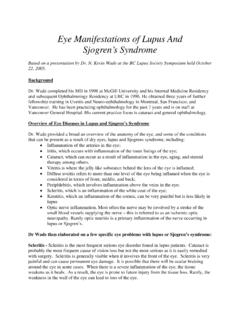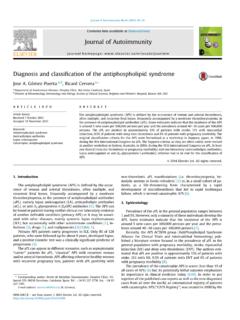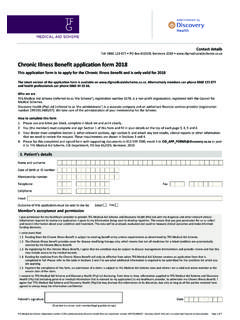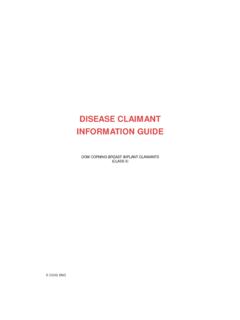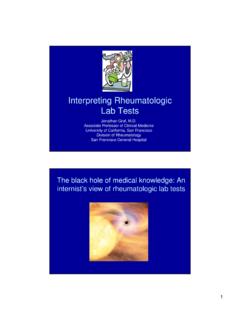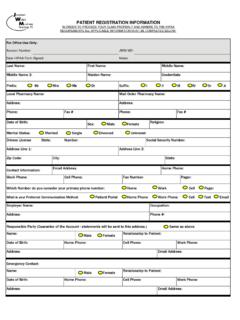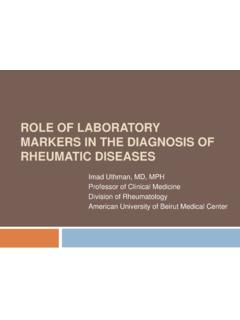Transcription of Gluten Intolerance and Rheumatic Diseases - IFSMED
1 Gluten Intolerance and Rheumatic Diseases Dr. Alexander Shikhman MD PhD FACR. Institute for Specialized Medicine November 2011. Case Study 42 woman presumable fibromyalgia Developed severe eye, mouth and vaginal diagnosis dryness Seeking second opinion regarding the nature Stopped the drugs and management of her pain Consulted by a rheumatologist and Developed pain in her muscles and joints diagnosed with ankylosing spondylitis over 20 years ago that coincided with initial onset of endometriosis Started anti-inflammatory drugs and then intravenous infusions of Remicade Seen by a local pain management physician Therapy did not affect her pain level, but Diagnosed with fibromyalgia and started on resulted in recurrent sinus infections anti-depressants Drugs discontinued after 6 months Case Study Main complaints during initial consultation included: Generalized muscle pain Fatigue Morning stiffness Eye, mouth and vaginal dryness Osteoporosis Frequent migraine headaches Irregular bowel movements with a predominant constipation Bloating Case Study Her family history was pertinent Physical examination was pertinent for: for: Osteoporosis Skin rash over shoulders Irritable bowel syndrome Eye and mouth dryness sjogren ' s syndrome Mild abdominal tenderness Hypothyroidism Generalized muscle tenderness Lab test results: Her endoscopy was requested and Mild anemia due to iron small intestinal biopsy was negative for deficiency celiac disease Low level of vitamin D.
2 Positive genetics for celiac disease associated genes Case Study Patient went on Gluten -free diet Started oral iron and vitamin D supplementations One month after initiation of the Gluten -free diet, her pain subsided by 40-50%. In three months she became pain-free Accidental consumptions of Gluten resulted in a transient near complete reproduction of her pain Six months after initiation of the Gluten free diet, she started noticing improvement of the mucosal dryness Currently, two years after initiation of the diet, the patient is still symptom free Gut and Rheumatic Disease The gastrointestinal system is the main entry for foreign materials (foods). into the human body and the main transitory route for an enormous mass of microorganisms and products of their activity in the form of feces. In an average person, the absorptive surface area of the small intestine is roughly 2700 square feet - the size of a tennis court The total alveolar area of the lungs is equal to 1700 square feet In comparison, the average skin surface area is only 17 square feet Gut and Rheumatic Disease Food and microbial products are the main stimulants of the immune system and the main external regulator of various metabolic pathways.
3 Accordingly, composition of the consumed food can influence immune responses and inflammatory processes leading to the development of distinct forms of Rheumatic Diseases . Focus on Gluten Intolerance Most common food-driven autoimmune disease affecting humans 10 to 35% of general population are genetically predisposed The mortality rate in patients with Gluten Intolerance exceeds that in the general population by a factor of 1 9 . 3 8, mainly due to malignant Diseases After 1 5 years on a Gluten -free diet, the reduction in excess mortality suggests that this diet is protective against malignant Diseases in patients with Gluten Intolerance Dietary Grains and Proteins that Trigger Gluten Intolerance GRAIN PATHOGENIC PROTEINS. WHEAT GLIADINS. RYE SEKALINS. BARLEY HORDEINS. DURUM. SPELT. TRITICALE GLIADIN-LIKE PROTEINS. KAMUT. EINCORN. Gluten Intolerance a disease that goes against the grain Gluten Intolerance is a permanent, genetically based Intolerance to ingested Gluten that results in chronic inflammation and systemic autoimmune responses Why Gluten ?
4 Human digestive enzymes cannot completely digest Gluten in the gastrointestinal tract Consumption results in formation of large protein fragments stimulating inflammatory reaction within the intestinal wall Gluten peptides can penetrate in systemic circulation and trigger immune responses in internal organs distant from the intestine (thyroid gland, salivary glands, brain etc). Gluten peptides can be detected in breast milk and can trigger various undesirable reaction in breast-fed infants Genetics of Gluten Intolerance Patients with Gluten Intolerance demonstrate a strong association with specific HLA class II. genotypes If people genetically predisposed to Gluten Intolerance do not ingest Gluten , the illness will not manifest Genetics of Gluten Intolerance Approximately 95% of patients with Gluten Intolerance have a particular type of HLA. DQ alpha and beta chain encoded by two genes, HLA-DQ2 (85- 90%), and HLA-DQ8 (5- 10%).
5 Immunology of Gluten Intolerance T lymphocytes invariably recognize Gluten peptides that are presented by HLA-DQ2 orDQ8. molecules. This results in the lymphocyte activation and initiation of the inflammatory reaction and autoimmune responses. Genetics of Gluten Intolerance MYO9B (myosin IXB). gene polymorphisms is associated with celiac disease, ulcerative colitis, SLE and RA. susceptibility, presumably through alteration of the intestinal permeability Spectrum of Gluten Intolerance Celiac disease 3-5%. Gluten Intolerance without 60-70% celiac disease will be 30-35%. affected by 35-40% will develop Rheumatic Gluten Intolerance Diseases during their lifetime Latent Gluten Intolerance HLA DQ2 or DQ8 +. without clinical symptoms 60-70%. Gastrointestinal Involvement in Gluten Intolerance Metabolic Problems Associated with Gluten Intolerance Malabsorbtion of vitamins (vitamin D, A, E, K, B1, B6), macroelements (iron, calcium, magnesium) and microelements (zinc, copper selenium).
6 Leaky gut syndrome Pernicious anemia (vitamin B12 deficiency due to autoimmune damage of gastric parietal cells). Osteoporosis Disbacteriosis Rheumatic Diseases Commonly Associated with Gluten Intolerance OSTEOPOROSIS. PSEUDOGOUT SACROILIITIS. FIBROMYALGIA DERMATOMYOSITIS. sjogren 'S Gluten PSORIASIS/PSORIATIC. syndrome ARTHRITIS. Intolerance . sjogren ' s syndrome sjogren ' s syndrome is an autoimmune disease affecting glands that produce tears and saliva (the lacrimal and salivary glands). Damage to these glands causes a reduction in both the quantity and quality of their secretions. sjogren ' s syndrome Main symptoms are: Dry eyes burning or itching, sandy feeling, blurry vision, light sensitivity Dry mouth chalky or cotton like, difficulty swallowing, speaking, or tasting, dental decay (cavities) and mouth infections. sjogren ' s syndrome Effects on other parts of the body: multiple sites of joint and muscle pain prolonged dry skin skin rashes on the extremities chronic dry cough vaginal dryness numbness or tingling in the extremities prolonged fatigue that interferes with daily life Fibromyalgia Fibromyalgia meaning muscle and connective tissue pain.
7 Is a disorder classified by the presence of chronic widespread pain and a heightened and painful response to gentle touch. Fybromyalgia Other core features of the disorder include: debilitating fatigue sleep disturbance joint stiffness difficulty with swallowing functional bowel and bladder abnormalities difficulty breathing diffuse sensations of numbness and tingling (non-dermatomal paresthesia). abnormal motor activity ( nocturnal myoclonus, sleep bruxism). cognitive dysfunction Osteoporosis Bone disease that leads to an increased risk of fracture Bone mineral density is reduced Bone microarchitecture is disrupted Amount and variety of non- collagenous proteins in bone is altered No specific symptoms Increased risk of bone fractures. Osteoporotic fractures are known as fragility or stress fractures. Typically, these fractures occur in the vertebral column, rib, hip and wrist Gluten Intolerance increases risk of osteoporosis due to malabsorbption of vitamins (vitamin D in particular), minerals and microelements Pseudogout Calcium Pyrophosphate Deposition Disease Type of arthritis that can mimic gout, and represents an inflammatory body reaction to the crystal deposits of calcium pyrophosphate Can cause severe episodes of localized pain and swelling resulting in incapacitation Can cause more chronic arthritis that mimics osteoarthritis or rheumatoid arthritis Knees are most often involved but wrists, shoulders, ankles, elbows or hands can be affected The most common cause of pseudogout in patients with Gluten Intolerance is vitamin D deficiency causing secondary hyperparathyroidism Rheumatic Diseases Less Commonly Associated with Gluten Intolerance Scleroderma Rheumatoid Arthritis SLE.
8 JRA. SLE Symptoms with Potential Gluten - Driven Mechanism Aphtous stomatitis Intestinal vasculitis Mucosal dryness /. sjogren ' s syndrome Methotrexate Intolerance Thyroiditis SLE Symptoms with Potential Gluten - Driven Mechanism CNS lupus: seizures, brain fog , vasculitis, encephalopathy Peripheral neuropathy Anti-phospholipid antibody syndrome Osteoporosis Malar rash Persistent lymphadenopathy Nonrheumatic Diseases Commonly Associated with Gluten Intolerance IRRITABLE. DERMATITIS CELIAC. BOWEL AUTISM. HERPETIFORMIS DISEASE. syndrome . BIPOLAR SECONDARY PERIPHERAL. ADDH. DISORDER HYPERPARATHYROIDISM NEUROPATHY. CHRONIC FATIGUE. SEIZURE DISORDER SCHIZOPHRENIA. syndrome . Indicators of Gluten Intolerance Medical History Thyroid disorders Irritable bowel syndrome Iron deficiency Osteoporosis sjogren ' s syndrome Asthma Indicators of Gluten Intolerance Skin Conditions KERATOSIS PERIUNGUAL DERMATITIS. PILARIS ERYTHEMA HERPETIFORMIS.
9 Laboratory Findings Suspicious for Gluten -Driven Autoimmune Process Low levels of vitamin D1 or D3. Elevated PTH. Positive anti-neuronal antibodies Positive anti-SSA/SSB antibodies Positive anti-cardiolipin antibodies Hyperprolactinemia Persistently elevated b2-microglobulin Positive anti-TPO antibodies Low level of vitamin A or retinol How to Diagnose Gluten Intolerance Genetic testing Immunologic testing blood Feces Intestinal / colon biopsy Elimination diet with subsequent Gluten challenge Treatment of Gluten Intolerance ELIMINATION OF. Gluten . CORRECTION. TUMOR OF. SURVEILLANCE METABOLIC. DISORDERS. CORRECTION. OF. IMMUNE. RESPONSES. Elimination of Gluten Management of Desorption of Gluten -Free Gluten Gluten from Diet Contamination Intestinal Lining Elimination of Gluten Gluten -containing grains to avoid Wheat Bulgar Filler Wheat Bran Couscous Triticale Wheat Starch Durum Kamut Wheat Germ Einkorn Matzo Flour/Meal Emmer Barley Semolina Faro Barley Malt/Extract Spelt Rye Graham Flour Elimination of Gluten Obvious Sources Potential Sources Bread Candy Bagels Communion wafers Cakes Cured pork products Cookies Drink mixes Gravy Pasta/noodles Imitation meat/seafood Cereal Sauce Patries/pies Self-basting turkeys Rolls Soy sauce Elimination of Gluten Lipstick/gloss/balms Mouthwash/toothpaste Play dough Stamp and envelope glues Prescription or OTC medications Vitamin, herbal and mineral preparations Elimination of Gluten Only 50% of Americans with a chronic illness adhere to their treatment including.
10 Diet Exercise Medication Dietary compliance can be the most difficult aspect of treatment Correction of Metabolic Disorders Management of malabsorption and leaky gut syndrome Therapy of hormonal imbalance Management of osteopenia and osteoporosis Correction of Metabolic Disorders Low Iron Low B6 (rare). Low Folate Low Beta-carotene Low Vitamin B12 Low Zinc Low Vitamins ADEK Essential fatty acid Low Thiamine deficiency Low Niacine Correction of Immune Responses Therapy of autoimmune disorders Normalization of gastrointestinal ecology Tumor Surveillance Biochemical markers Physical surveillance Institute for Specialized Medicine ( ) was founded in San Diego in 2008. The mission of the institute is to provide comprehensive medical care for chronic inflammatory, autoimmune and metabolic Diseases Our philosophy is based on an integrative approach of patient care, which includes the most advanced technologies in traditional medicine in combination with the best of complementary therapies Alexander R.
